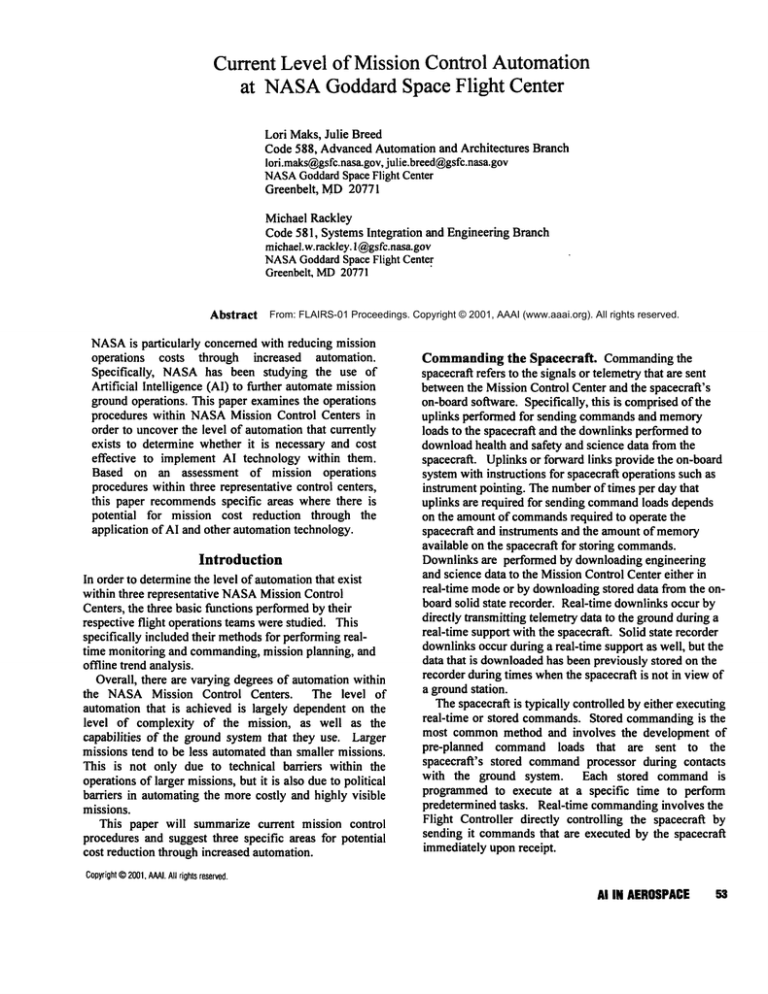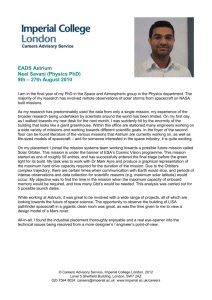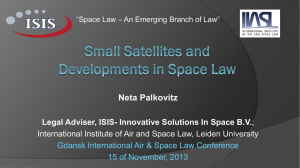
CurrentLevel of Mission Control Automation
at NASAGoddardSpace Flight Center
Lori Maks, Julie Breed
Code 588, AdvancedAutomation and Architectures Branch
Iori.maks@gsfc.nasa.gov,
julie.breed@gsfc.nasa.gov
NASA
GoddardSpace Flight Center
Greenbelt, MD20771
Michael Rackley
Code581, Systems Integration and Engineering Branch
michael.w.rackley.1 @gsfc.nasa.gov
NASA
GoddardSpace Flight Center
Greenbelt, MD20771
Abstract
From: FLAIRS-01 Proceedings. Copyright © 2001, AAAI (www.aaai.org). All rights reserved.
NASA
is particularly concerned with reducing mission
operations costs through increased automation.
Specifically,
NASAhas been studying the use of
Artificial Intelligence (AI) to further automate mission
ground operations. This paper examinesthe operations
procedures within NASAMission Control Centers in
order to uncoverthe level of automationthat currently
exists to determine whether it is necessary and cost
effective to implement AI technology within them.
Based on an assessment of mission operations
procedures within three representative control centers,
this paper recommendsspecific areas where there is
potential for mission cost reduction through the
application of AI and other automationtechnology.
Introduction
In order to determinethe level of automationthat exist
within three representative NASA
Mission Control
Centers, the three basic functions performedby their
respective flight operations teams were studied. This
specifically included their methodsfor performingrealtime monitoring and commanding,mission planning, and
offline trend analysis.
Overall, there are varying degrees of automation within
the NASAMission Control Centers. The level of
automation that is achieved is largely dependent on the
level of complexity of the mission, as well as the
capabilities of the ground system that they use. Larger
missions tend to be less automated than smaller missions.
This is not only due to technical barriers within the
operations of larger missions, but it is also due to political
barriers in automating the more costly and highly visible
missions.
This paper will summarize current mission control
procedures and suggest three specific areas for potential
cost reduction through increased automation.
Commandingthe Spacecraft. Commanding the
spacecraft refers to the signals or telemetrythat are sent
betweenthe Mission Control Center and the spacecraft’s
on-boardsoftware. Specifically, this is comprisedof the
uplinks performed for sending commandsand memory
loads to the spacecraft and the downlinksperformedto
downloadhealth and safety and science data from the
spacecraft. Uplinks or forward links provide the on-board
systemwith instructions for spacecrat~ operations such as
instrument pointing. The numberof times per day that
uplinks are required for sending commandloads depends
on the amountof commands
required to operate the
spacecraft and instruments and the amountof memory
available on the spacecraft for storing commands.
Downlinksare performed by downloading engineering
and science data to the MissionControl Center either in
real-time modeor by downloadingstored data from the onboard solid state recorder. Real-time downlinks occur by
directly transmitting telemetry data to the groundduring a
real-time support with the spacecraft. Solid state recorder
downlinksoccur during a real-time support as well, but the
data that is downloadedhas been previously stored on the
recorder during times whenthe spacecraft is not in view of
a groundstation.
The spacecraft is typically controlled by either executing
real-time or stored commands.Stored commandingis the
most commonmethod and involves the development of
pre-planned command loads that are sent to the
spacecraft’s stored commandprocessor during contacts
with the ground system. Each stored command is
programmedto execute at a specific time to perform
predetermined tasks. Real-time commandinginvolves the
Flight Controller directly controlling the spacecraft by
sending it commandsthat are executed by the spacecraft
immediately upon receipt.
Copyright
©2001,
AAAI.
All rightsreserved.
AI IN AEROSPACE53
Real-time commandingis typically performed for
routine activities wherethe Flight Controller requires
feedback from the spacecraft (i.e., telemetry) while
commanding. Examples might include managing the
dumping of the on-board recorder and performing
maneuvers.In certain emergencysituations, such as when
the spacecraft’sstate of healthis in dangerandthere is no
time to generate a stored commandload, the Flight
Controllermayneedto utilize real-time commanding.
There are two different
methods used as a
communication link between the spacecraft and the
MissionControl Center: groundstations and the Tracking
& Data Relay Satellites (TDRS).Groundstations are
communication
stations that are located all over the world
and serve as the first communicationpoint for the
transmissionof telemetrydata fromsatellites to the ground
system. TheTDRS
satellites are a constellation of six
satellites whichform the space-basedportion of NASA’s
Space Networkthat support communicationwith other
satellites fromspace. Requestsfor the use of any of the
TDRSsatellites are scheduled through the Network
Control Center (NCC).
MissionPlanning.Missionplanning involves all of the
activities requiredto planfor the contactswiththe
spacecraft. Specifically, this involvesthe coordination
betweendifferent organizationsto schedulethe use of
either TDRS
or a groundstation duringtimes whena
particular satellite is in view.Typically,MissionControl
Centersuse a flight dynamicssystemto generateorbit data
that is factoredinto the communication
schedule.
Additionally, mission planning involves building the
commands
that are sent to the spacecraft to control and
instruct it. For large missions,there is a separatemission
planning team that is responsible for coordinating the
schedulefor contacts with the spacecraft and buildingthe
command
loads. For smaller missions, these functions are
typically performed
by the Flight Controllers.
TrendAnalysis. Trendanalysis is the analysis of
spacecraft engineeringtelemetrydata for the purposeof
predictingpotential anomaliesthat mayoccurin spacecraft
components.Analysis of this data must be performed
regularlyto ensurethat the scienceinstrumentsare
operatingproperlyso that they can makeaccurate
observations.Additionally,this analysis mayprevent
unsafeconditionswhichcouldcause the loss of an
instrumentor other component.Thetelemetry data
typically gets automaticallytransferred fromthe ground
systemto an analysis systemwithin the MissionControl
Centerthat archivesandstores it. Varioustypes of
statistical reports maybe run by retrievingandplotting this
data.
54
FLAIRS-20Ol
Mission Observations/Interviews
Three representative NASA
Mission Control Centers
wereobservedin order to analyzetheir daily operationsby
physically sitting with the Flight OperationsTeamsand
documentingtheir activities. Interviews were also
conducted with team membersto elicit feedback. The
missions studied were: the Small Explorer (SMEX)
missions, the Earth Observing System (EOS) Terra
mission, and the HubbleSpaceTelescope (HST)mission.
A summaryis provided of each mission’s proceduresand
level of automation.
Small Explorer (SMEX)Missions. The SMEX
MissionControlCenteris considereda multi-mission
facility; eachmissionoperatesindependently,yet
consistently. Themissionsthat are supportedby this
Control Centerare: Wide-FieldInfrared Explorer(WIRE),
Transition Regionand CoronalExplorer (TRACE),
SubmillimeterWaveAstronomySatellite (SWAS),
and
Solar Anomalous
and MagnetosphericParticle Explorer
(SAMPEX).
Theirnominalstaffed operationsare for 8 hoursa day, 5
days a week.Theyare not required to supporta 24-houra
day, 7-day workweekdue to the level of automationthat
they have achieved in support of these missions. They
have successfully automatedthe conductof all of their
spacecraft contacts, which includes configuring the
spacecraft and groundsystemfor the contact, dumpingthe
solid state recorder, and monitoringthe real-time health
and safety data. However,they do still manuallytransmit
their command
loads.
The groundsystemthat all four of the SMEX
missions
use to support their missionoperations is the Integrated
Test and Operations System(ITOS). ITOSmerely uses
SystemTest and Operations Language(STOL)procedures
to automatethe monitoringof the systemduring operator
off-duty hours. The primarycommunication
links between
the spacecraft and ITOSare the WallopsIsland and Poker
Flat ground stations. These missions also rely on the
Spacecraft EmergencyResponseSystem (SERS)to page
the appropriate engineer if the ITOSsystem detects a
potential problem in the spacecraft data that is
automatically downloadedduring off-duty hours. The
ITOSinterfaces with the SERSto executethis process.
The SMEX
mission planning function is performed
manuallyby the Flight Controllers. Thesystemthat they
use to build their commandloads is the Command
ManagementSystem (CMS). The Flight Controllers
prepare their owncommand
loads using the CMSto build
them. Althoughthe CMSsimplifies the building of the
commandloads, it appeared that manyof the tasks
performedwereperformedmanually,such as the retrieval
of the new procedures and the transfer of the old
proceduresto an archive directory within the system. The
communicationschedule for spacecraft contacts is
prepared by the WallopsPlanning Systemnetworkand a
weeklyscheduleis sent to the SMEX
facility.
The trend analysis system that SMEX
uses is the Data
Trending and Analysis System (DTAS).The ITOSsystem
providesDTAS
with the telemetry data that it gatheredand
processedduringcontacts with the spacecraft. Thedata is
used to makepredictionsby lookingat overall trends. The
teamnotes degradationin equipmentand predicts failures
with these reports. DTAShas successfully automated
someof the reporting that is performedby these missions,
suchas automaticallyperformingtheir daily trendingplots.
In general, the SMEXmissions are much more
automatedthan the other missionsthat werestudied. This
can be attributed primarily to their groundsystem, ITOS,
whichprovides themwith the capability of automating
their commanding
and the relative simplicity of operating
the missions.ITOSwasusedto its fullest capacity for the
Fast Auroral SnapshotExplorer (FAST)mission that has
nowbeen movedto Berkley, CA.This mission was fully
autonomous,except for their mission planning, for three
monthsbefore it was moved.The engineers supporting
this missionattribute its successto the stability of the
spacecraft and the numberof opportunities for making
contact with it. Thegreater the numberof opportunities
for contacts, the safer automationis for a particular
missionin that if errors occur in a transmission,there are
more opportunities to recover or resend any lost data.
Therefore,the greatest barrier for full automationof the
commanding
for the other SMEX
missions is that there are
problemsat times with lost data that tends to occurat the
ground stations. Skilled engineers are required to
troubleshootthese problems.
HubbleSpace Telescope (HST) Mission. HSTis
considereda Great Observatorymission, whichis
designated by NASA
as a long term space-basedgeneral
observerfacility. Dueto the size andpublic exposureof
this mission,it is heavilymanned
andmostof their
operations are performedmanually.Theteamsupports 24
hour a day, 7 days a weeknominaloperations.
The HSTFlight Operations Team (FOT) uses the
Control Center System (CCS)as their ground system.
Hubbletypically uses one of the TDRS
satellites as its
primary communication link to CCS. The commanding
that they performthrough CCSis still for the mostpart
manualin that all of the contact with Hubbleto send
command
loads to the spacecraft are performedby the
Flight Operations Team. Their commandloads that
support a 24-hour timeperiod include procedures that
execute at predefined times to automatically downlink
engineering and science data. The monitoring of the
engineeringdata is performedmanually24 hours a day by
the Flight OperationsTeam.
TheHSTmission planning function is nowperformedat
the STScI,therefore a thoroughstudy of this function was
outsidethe scopeof this study.
TheHubbletrend analysis function is a fairly manual
process. The Hubble System Engineers perform the
analysis of this engineeringdata daily by extrapolating
telemetry data fromthe electronic data warehousein CCS
to run reports. Theyimportthe data into either Microsoft
Wordor Excel and manipulateit accordingto the type of
report they needto run anddeveloptheir ownreports. The
trend analysisfunctionis definitely a candidatefor further
automation,as it requires the engineersto performmostof
this workmanually.
The lack of automationin Hubble’sflight operations
does not appearto be for technical reasons. Rather, it is
moreof a perceivedpolitical impactthat preventsfurther
automation.To a certain extent, their continuedmanual
processescan be attributed to the high visibility of this
mission, the impact to the science community if
observationtime is lost, the spacecraft changesthat occur
with each servicing mission, and the risk of damaging
publicity if anomaliesoccur or data is lost during an
automated pass. There are plans for upgrading their
groundsystem sometimein the future to increase their
levels of automation,particularly onceservicing missions
are no longer planned.
Terra Mission. The Terra Mission Control Center is
part of NASA’s
Earth SciencesEnterprise (ESE)and is one
of the EarthObservatory
missions.It is also a very large
missionand is comparablein size and complexityto
Hubble.It has someof the sameconstraints with regard to
automationas Hubbledoesdueto its visibility andsize.
Although,the Terra Flight OperationsTeamis considering
the implementation
of further automationinto their
operations,currently all of their communication
with the
spacecraft is still performedmanually.TheFOTalso
manuallymonitorsTerra’s engineeringdata continuously
throughoutthe day. Theteamsupports24 hour a day, 7
days a weeknominaloperations.
The ground system that the Terra Flight Operations
Teamuses to support their real time commandingand
monitoring is the Eclipse system.
The primary
communication
link betweenthe spacecraft and Eclipse are
the TDRS
satellites.
TheTerra mission planning function is supportedby a
team of people that are responsible for developingthe
following planning products: the Detailed Activity
Schedule,whichis a daily schedulethat outlines all onboardactivities for the next day, the NCC
schedulerequest
for TDRS
supports, the groundstation schedule request,
the command
loads prepared for uplinking to Terra, and
several different types of reports for engineer and FOT
review.
They perform these tasks using the Mission
ManagementSystem (MMS)to develop their planning
products. MMS
does provide the planning staff with a
certain level of automationthat simplifies the preparation
of these products and it will generate routine stored
AI IN AEROSPACE
SS
commandsequences automatically. However, there are
still manytasks that require somelabor-intensive work by
the planning staff and that could be further automated. As
an example, the planning team must execute the scripts
that automate their processes by entering in several UNIX
commands
in multiple UNIXterminal sessions. All in all,
further automation of the mission planning process would
simplify these procedures for the planning staff, although
they have madedefinite strides in automatinga great deal
of their tasks.
The trend analysis system that is used by the Terra
engineers is supported by the Epoch 2000 system, which
performs the telemetry processing, and the Archive
Browser and Extractor (ABE) system. ABEis used
retrieve and analyze the Terra engineering data and to
generate trending reports. The ABEsystem automatically
generates batch reports on a daily basis for the engineers to
review. In most cases, the engineers use the ABEsystem
themselves and generate their ownreports. Someof this
daily routine reporting performed by the engineers could
be further automated. Furthermore, all of the analysis and
predictions madeby the engineers is performed manually.
If the analysis of this data were automated, more of the
data could be analyzed and the process of predicting
potential anomalies would becomemuchmore efficient.
On the whole, additional automation for the Terra FOT
could significantly improve their processes. Originally,
they had planned to implementa system called the Flight
Operations Segment (FOS), which would have automated
more of their commanding,however this system was very
unreliable and had to be replaced with the current Eclipse
system one year before the launch of Terra. One of the
barriers
to automating more of their commanding
processes is that the Eclipse system must interface with
other systems to perform typical ground system functions.
Increasing the degree that their systems are integrated
could greatly facilitate the incorporation of increased
automation throughout the system. Another barrier that
inhibits additional automation within the FOTis that the
data rates for communication between the solid state
recorder and the Terra instruments vary throughout the
day, depending on instrument activities. It wouldbe very
difficult, if not impossible, to modelthis dynamicprocess
with the current Eclipse system.
Conclusions
Overall, the larger missions (Terra and Hubble) were
much less automated than the smaller missions (SMEX),
This is not only due to technical barriers, such as the
limitations oftbeir groundsystems, but it is also due to the
higher complexity and visibility, as well as the unique
culture of the larger missions.
The capabilities of the ground system that are used by
the mission are a major factor that determines the level of
automation. For example, the ITOS system used by the
S6
FLAIRS-2001
SMEXmissions provides the capability
of fully
automating their commanding.On the other hand, the
CCSsystem used by Hubble does not currently provide
this capability and neither does the Eclipse systemthat is
used by Terra.
Additionally, cultural and political barriers determine
the level of automationas well. For example,in all of the
missions that were studied, it was difficult for the
engineers that support flight operations to fully trust an
automated system to perform the critical function of
communicationwith the spacecraft. There are legitimate
concerns for the loss of data during an automated
transmission that maynot be recoverable if an engineer is
not alerted to the problemin time. In the ease of the larger
missions, missing data wouldbe very politically damaging
and could impact funding for the project. However,for the
smaller missions, these issues are not as muchof a concern
since the science data gathered by the smaller missions is
not as publically followedas with the larger missions.
There are three potential candidates for further
automation within flight operations. First, the mission
planning systems for each of the missions studied all
provided somelevel of automation for building schedules
and command
loads, but they all still tended to require a
great deal of manualtransferring of files, preparation of
reports, etc. Second,the trend analysis functions for each
mission are still manual to semi-automated in nature.
While Hubble does not even have a dedicated trend
analysis system, the SMEXand Terra operations have
dedicated systems but there is still a fair amountof manual
reporting that is performed.Additionally, the analysis and
predictions of the data that are trended is performed
manuallyfor all of the missions that were studied. Lastly,
commanding
could be further automated, especially for the
larger missions that still perform manualcommanding
for
the downlinking of data. The FASTmission was the only
mission studied that successfully automatedthe uplinking
of commandloads, although this function could also be
automated for other missions as well. The FASTmission
was one of the smaller class missions and was a stable
noncomplexspacecraft.
The SMEXmissions were the most successful of the
missions that were evaluated in automating their flight
operations. Surprisingly, they accomplishedthis by using
unsophisticated automation techniques, such as the use of
STOLprocedures for off-duty monitoring. In contrast to
this, AI automationtechniques, such as expert systems, are
much more complex and time consuming to implement.
For example, expert systems that have been implemented
within other NASAmissions, such as GROand RXTE,
have taken much longer to implement than originally
anticipated. This is due to the fact that it is very difficult
to capture the knowledgeof the Flight Controllers into a
set of rules that can be used within the expert systems, It
is also time consumingto test the rules to ensure that they
are completely accurate. Consequently, it is questionable
whether implementing AI technology within small to
mediumsized Mission Control Centers is worth the time
investment. For large, complex, and long-duration
missions, the implementation of expert systems is more
cost effective.
Acknowledgements. The author would like to express
appreciation to the missions that were observed and
interviewed, particularly John Nagyand WendyJones of
SMEX,Pete Pataro and Dick Turcotte of HST, and John
Teter and Brad Proffitt of Terra.
References
Daryl G. Bodenand Wiley J. Larson, t996, Cost-Effective
Space Mission Operations, McGraw
Hill, Inc.
Jim Gaczh, February IS, 2000, "SMEXExplorer’s
Program", NASA/GSFC,
url: http://sunland.gsfe.nasa.gnY/smex/
NASA/GSFC,2000, "Spacecraft Emergency Response
System",
url: http://smexvmoel.naseom.nasa.gov/
Space Telescope Science Institute,
url: http://www.stsei.edu/hst/
Edward J. Rodriguez,
Operations Concept".
2000, "AboutHST",
Terra Mission,
2000, "MMS
Miranda Cooter, George Davis, Jennifer Mackey, Michael
Rackley, December 2000, "Alternative Approaches to
Mission Control Automation at NASA/GSFC".
AI IN AEROSPACE57







